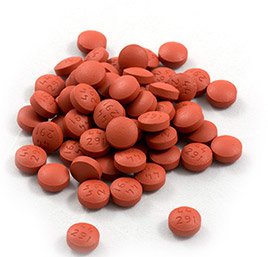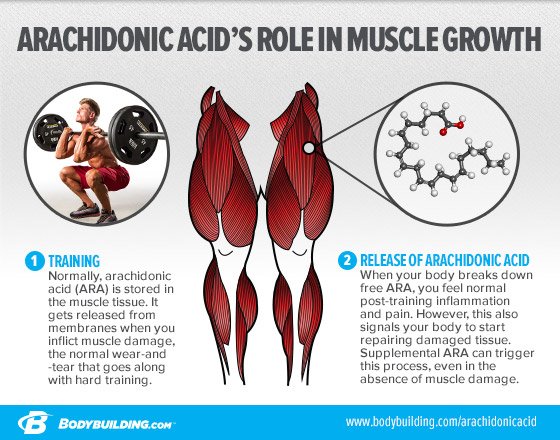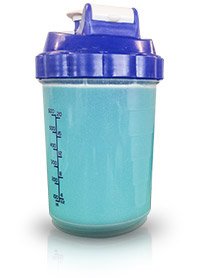Once upon a time, hard-training strength athletes were almost never seen without a certain trusty bottle in hand. It followed them in their gym bag wherever they went, and they were never comfortable unless they knew it was close by.

It wasn't the juice. It wasn't whey or creatine. It was NSAIDs—or non-steroidal anti-inflammatory drugs. You might know them by other names such as ibuprofen and naproxen.
Then, around the turn of the century, everything changed. Several studies determined that the body's muscle-building response to training was more or less shut off in people who regularly used anti-inflammatory drugs.1,2
It became clear that our bodies actually need acute inflammation to grow; without it, our potential to increase lean mass is blunted. While many strength athletes—and many more endurance athletes—still use these drugs periodically, the days of the Advil-popping bodybuilder were numbered.
But there's more for strength athletes to take away from this story than just "Lay off the pain pills." It also raises a question: What if there was a way to strategically—or supplementally—induce the type of inflammation that leads to muscle growth? This would seem ideal for those inevitable times when your progress has stalled and you've started using the dreaded P-word.
There is such a supplement. It's called arachidonic acid (ARA or AA), and research is showing that it has great potential to be a potent new tool in the modern athlete's nutritional arsenal.
WHAT IS ARACHIDONIC ACID?
Basically, ARA is the primary fatty acid responsible for inflammation in muscle tissue. This 20-carbon omega-6 fatty acid resides in the cell membranes of our muscles, known as the sarcolemma. When your muscles are damaged by lifting weights, certain enzymes flock toward the affected area and "free" the ARA from the membrane.
When this happens, the freed ARA gets broken down and used to create small localized hormones called prostaglandins, which more directly cause the inflammation and pain we feel post-training. That may sound negative, but on the flip side, these inflammatory mediators also signal the body's repairing response in muscle tissue. Additionally, they play a critical role in increasing the amount of nuclei in our muscle cells, ultimately boosting muscle protein synthesis.3

This is the process that gets affected when you take NSAIDs. But even if you don't, the process quickly depletes the levels of ARA in your muscle tissue. Without ARA, you all but lose the short-term inflammation essential for building new muscle tissue. For this reason, some researchers theorize that low ARA levels are one of the primary factors contributing to the "plateau" effect in resistance training.
I'm sure most individuals reading this article have experienced this phenomenon. The first few times you lift weights, or return to the weights after a time away, you might feel soreness and inflammation afterward, but as you adapt to the training stimulus, those sensations decrease. Over time, so do your results. Your ARA levels appear to be central to this process.
WHERE DOES ARA COME FROM?
Arachidonic acid isn't considered an essential fatty acid, because your body can synthesize it from linoleic acid in the liver. However, this is an inefficient process, and simply improving your linoleic acid intake—as happens when you eat more healthy fats and oils—doesn't predictably improve levels of ARA.4 While you do get some ARA from food sources like chicken, eggs, beef, and fish, research indicates there are benefits to supplementing beyond this point.

Recently, my colleagues at the University of Tampa put ARA to the test in a double-blind, eight-week study.5 Here's the catch: We didn't periodize the training regimen, unlike other studies into the effects of ARA.6
Often, people consider an unperiodized program to be a sign of a weak study, but in this case, it was intentional. Other studies into ARA have used a periodized program that presented an evolving training stimulus, but we wanted to give the subjects every opportunity to plateau in their training.
So what happened? The group supplementing with ARA displayed significantly greater lean body mass, strength, and power over the placebo group after eight weeks of training. The ARA supplementation, it appeared, was able to prevent training adaptation from happening, allowing inflammation-induced growth to continue beyond traditional levels.
GAINS LIKE BACK IN THE DAY
At this point, it's logical to ask, "How could this have any benefit for me if I periodize my training?" It's a fair question. Periodization is essential for effective long-term training, but it's by no means a guarantee that you'll keep improving forever.
Particularly as athletes grow more advanced in their training and muscular development, they often find themselves stalling quickly and using tricks to chase after tiny incremental gains.

For that reason, ARA seems likely to be most beneficial for three types of athletes:
-
Athletes who struggle to push past plateaus, even with periodization.
-
Athletes such as powerlifters, who utilize a taper period to maximize their performance on a given day, but who don't want to lose the gains they've made leading up to the taper.
-
Highly trained individuals looking for an extra boost to performance and muscle growth.
Have you ever heard an experienced strength athlete talking wistfully about their "beginner gains?" The idea behind supplementing with ARA is that it will help your body experience the type of dramatic stimulus you thought was only reserved for newbs.
HOW SHOULD I TAKE IT AND STACK IT?

Based on the most recent study, it appears that 1.5 g of ARA per day is effective for improving performance and body composition. The dosage also seems to be quite sensitive, considering prior research was unable to demonstrate similar ergogenic properties utilizing 1 g per day. Many ARA supplements only provide 250 mg per serving, so consider upping the dose accordingly.
At the moment there hasn't been much research looking at how ARA interacts with other supplements. However, it seems logical that you would combine it with supplements that have been shown to boost recovery, such as HMB and BCAAs. In this way, you could provoke a greater muscle-damage response with ARA, while also maximizing your body's ability to rebuild the damaged tissue.
Another interesting stack is the combination of ARA with fish oil. Research indicates that the omega-3 fatty acids in fish oil may help to "knock out" the ARA located in phospholipids, allow the body to metabolize it faster at the site of muscle damage.7 Omega-3s are also increasingly accepted for their anti-inflammatory properties, so they're a natural complement to ARA.8
In fact, newer ARA supplements even include moderate amounts of fish oil formulated within the capsule.
BUT … DOESN'T INFLAMMATION HURT?
While ARA is considered pro-inflammatory, supplementation seems to only confer this effect during and after training. Interestingly, ARA supplementation is actually associated with reduced inflammatory markers at rest.6 Furthermore, research did not find any significant negative health outcomes in subjects consuming 1.5 grams of ARA per day for 50 days.9
Still, it might be a better idea to avoid ARA if you have any pre-existing conditions or injuries that may be worsened by inflammation. There have also been some anecdotal reports of more intense delayed-onset muscle soreness with ARA supplementation. It's prudent to cycle off of ARA if soreness becomes too intense or if there is an unrelated injury.
WHAT'S THE BOTTOM LINE?
More research needs to be performed in order to cement ARA's ergogenic properties, but the results to date show promise. Research to date indicates it may be an effective way to maximize your body's natural response to training, allowing you to break through barriers and get the most out of the hard work you do in the gym.

References
- Trappe, T., White, F., Lambert, C., Cesar, D., Hellerstein, M., & Evans, W. (2002). Effect of ibuprofen and acetaminophen on post-exercise muscle protein synthesis. American Journal of Physiology, 282(3), E551-6.
- Trappe, T., Fluckey, J., White, F., Lambert, C., & Evans, W. (2001). Skeletal muscle PGF(2)(alpha) and PGE(2) in response to eccentric resistance exercise: Influence of ibuprofen acetaminophen. Journal of Clinical Endocrinology and Metabolism, 86(10), 5067-70.
- Markworth, J., & Cameron-Smith, D. (2011). Prostaglandin F2-alpha stimulates PI3K/ERK/mTOR signalling and skeletal myotube hypertrophy. Am J Physiol Cell Physiol, 300(3), C671-82.
- Rett, B., & Whelan, J. (2011). Increasing Dietary Linoleic Acid Does Not Increase Tissue Arachidonic Acid Content in Adults Consuming Western-Type Diets (Doctoral dissertation, University of Tennessee, Knoxville).
- Ormes, J., Sharp, M., Joy, J., Lowery, R., McCleary, S., Shields, K., ... Wilson, J. (2014). Effects of Arachidonic Acid Supplementation on Skeletal Muscle Mass, Strength, and Power. Journal of Strength & Conditioning Research. Abstract.
- Roberts, M., Iosia, M., Kerksick, C., Taylor, L., Campbell, B., Wilborn, C., ... Kreider, R. (2007). Effects of arachidonic acid supplementation on training adaptations in resistance-trained males. Journal of the International Society of Sports Nutrition, 4(1), 1-13.
- McMurchie, E., Margetts, B., Beilin, L., Croft, K., Vandongen, R., & Armstrong, B. (1984). Dietary-induced changes in the fatty acid composition of human cheek cell phospholipids: Correlation with changes in the dietary polyunsaturated/saturated fat ratio. American Journal of Clinical Nutrition, 39(6), 975-80.
- Kiecolt-Glaser, J., Belury, M., Andridge, R., Malarkey, W., & Glaser, R. (2011). Omega-3 supplementation lowers inflammation and anxiety in medical students: A randomized controlled trial. Brain, Behavior, and Immunity, 25(8), 1725-34.
- Kelley, D., Taylor, P., Nelson, G., & Mackey, B. (1998). Arachidonic Acid Supplementation Enhances Synthesis Of Eicosanoids Without Suppressing Immune Functions In Young Healthy Men. Lipids, 33(2), 125-130.
